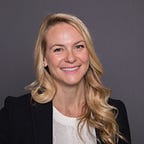Owning Customer Centricity at Your Company
For Customer Marketers who want to build a culture around customers across their company.
A few weeks ago, I spoke at the Summit on Customer Engagement. The gathering is hosted in Silicon Valley primarily for marketing professionals in B2B technology companies who design customer marketing reference, or advocacy programs.
This year, I shared a framework for thinking about Customer Centricity that I use in my role as the Director of Customer Marketing at Outreach.
I’ve re-worked my speaker notes to be more readable, and I’ll be sharing them in a 3-part series. This is part 1.
If you’d like an update when parts 2 and 3 come out, follow me on Medium or write your email in at the form on the bottom of the post.
My professional background is in both Sales and Marketing — Customer Marketing, specifically.
Fast growth SaaS tech companies are where I’ve spent most my career over the past 9 years. I cut my teeth at Box where I built Customer Marketing from the ground up back in 2011. Since then, my expertise is around just that — building Customer Marketing departments from scratch.
Over the years, a lot of people have come to me for advice on how to structure Customer Marketing and I’ve brainstormed with and learned from many Customer Marketers, some more veteran than I.
For all Customer Marketers, I’ve found that we all hold one truth:
Many companies want to be customer-centric, but most don’t know how to put that into practice.
Or — many companies talk the talk, but don’t know how to walk the walk.
Over the years, when I’ve talked with my fellow Customers Marketers (or Community Managers, Advocate Marketers, Reference Program Managers, Customer Engagement Marketers — whatever their titles may be), we’re all usually trying to tackle three areas in the name of creating a more customer centric organizations:
Each of these challenges is dense, so I’m going to deconstruct each one in its own post. We’ll start with #1:
Centralizing Customer Marketing Programs
A very common challenge I hear from Customer Marketers is that their programs are decentralized or done on an ad hoc basis. Decentralization can take many forms, but what I’ve heard most frequently is:
From my friends in large companies
There are dedicated customer marketing functions, but they’re rolling up to different departments. They are completely without cross-functional alignment on goals and are potentially overlapping on initiatives without knowing.
From my friends in smaller companies
Resources are strapped and there is no dedicated, centralized resource (person, team or technology) for their customer marketing programs. Instead, it’s shared across a bunch of different people to get the job done. And worse yet, nobody has time to focus on a strategy.
If you don’t have alignment, visibility or one common language for what’s happening with your customers, you’ll have a disjoined customer experience and customers will leave and go elsewhere.
That’s scary, so what I’ve done is built a Customer Centricity Model. Fun fact: I used this model in my interview with Outreach just over a year ago.
During the interview process, our VP of Marketing (and my current boss,👋🏼Katie) asked...
“How are you going to make sure our most excited users are activated?”
Manny, our CEO, asked…
“How are we going to create a movement to win hearts and minds?”
Our VP of Customer Success asked…
“What are we going to do to engage with the users we don’t market to today?”
In each conversation, I took pen to whiteboard and drew a triangle.
I broke this triangle out into three parts, each representing a different “Tier” or group of customers. On the left, I categorized and named the tiered segments and described what their descriptors are for us at Outreach.
On the right, I outlined different programs that aligned with the respective customer group.
By creating this model, what I built is a DEPARTMENTAL structure that supports customer centricity.
What’s key about this model is that it shows how critical it is that these programs build upon each other to create that movement that my CEO was asking for. When you look at the model and imagine an upward movement, you can see:
● When you execute Field Customer Programs, you support customers in the Field in moving to behavior that we want to see from Advocates.
● When we develop and support Advocate Customer Programs, customers are primed to enter the O-Suite.
● As we invest in our O-Suite Customer Programs, we breed and foster thought leaders who help tell the world the story of how they use your company.
When any customer that you’ve engaged with successfully leaves their post at the company they work at, they are primed to bring you with them to their next role and plant seeds for new leads for you.
As a Customer Marketer, now you can touch the whole customer journey and build this movement upon itself to create Customer Centricity.
What I’ve found valuable about this model is that once people understand the concept, you can use it to use this for different initiatives. For example, this could be useful for hiring:
What I’m doing here is building an ORGANIZATIONAL structure that supports Customer Centricity.
Another example could be the strategy and design around big projects, like a designing the customer experience at a user conference:
Repeating the trend, what I can do now is build a PROGRAM structure that supports Customer Centricity.
You now you have a model that explains why all customer programs should be strategically centralized, in one department, all under one triangular roof. And guess what? You can keep your customers, too. :)
Next week, I’ll publish part 2 of this series: Shifting company mindset from being customer focused to customer centric.
If you’d like an update when parts 2 and 3 come out, follow me on Medium or write your email in down here 👇🏽
